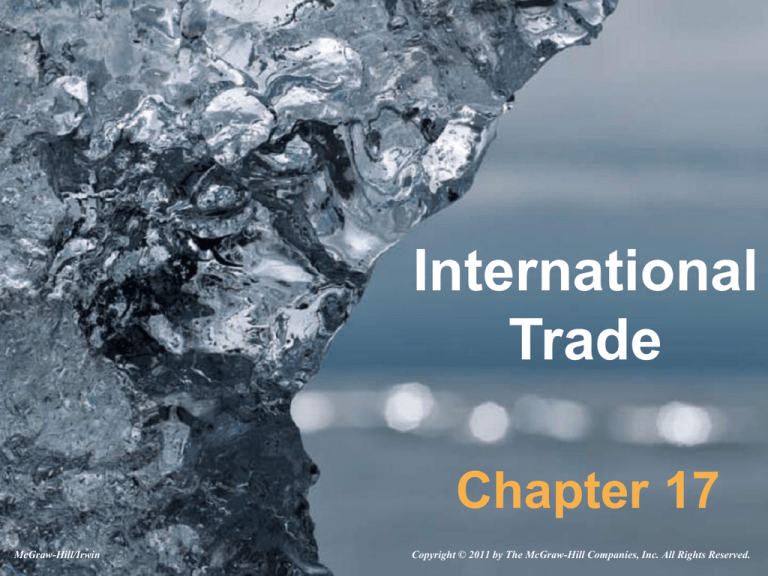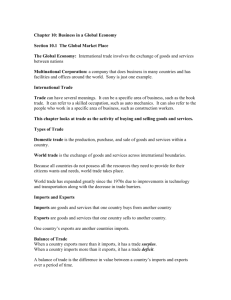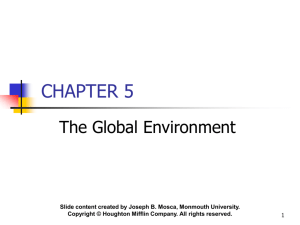
International
Trade
Chapter 17
McGraw-Hill/Irwin
Copyright © 2011 by The McGraw-Hill Companies, Inc. All Rights Reserved.
U.S. Trade Patterns
• Imports and Exports:
– Imports–goods and services purchased
from foreign sources.
– Exports–goods and services sold to
foreign buyers.
LO-1
17-2
Trade Balances
• Imports and exports are seldom equal.
– The trade balance is the difference
between exports and imports:
Trade balance = exports – imports
LO-1
17-3
Trade Balances
• Trade deficit – the amount by which
the value of imports exceeds the value
of exports in a given time period.
• Trade surplus – the amount by which
the value of exports exceeds the value
of imports in a given time period.
LO-1
17-4
Table 17.2
17-5
Trade Balances
• The U.S. typically has a merchandise
deficit, a services surplus, and an
overall trade deficit.
• Any imbalance in America’s trade must
be offset by reverse imbalances
elsewhere.
LO-1
17-6
Table 17.1
17-7
Trade Balances
• One result of the 2008-09 recession
was a decrease in the U.S. trade
position as consumers bought fewer
imports.
• The 2009 trade deficit dropped to $392
billion from $712 billion in 2007.
LO-1
17-8
Motivation to Trade
• Specialization increases total output.
• The gain from trade will be increased
world output and thus a higher
standard of living in both countries.
• Consumers gain more choice and the
potential for lower prices.
LO-2
17-9
Production and
Consumption without Trade
• The gains from trade may be illustrated
using a production possibilities curve:
– The production possibilities curve
defines the limits to what a country can
produce.
• In the absence of trade, a country
cannot consume more than it
produces.
LO-2
17-10
Consumption
Possibilities
• Without trade, a country’s consumption
possibilities equals its production
possibilities:
– Consumption possibilities–the
alternative combinations of goods and
services that a country could consume in
a given time period.
LO-2
17-11
Figure 17.1
17-12
Production and
Consumption with Trade
• Changing the mix of output results in a
higher level of total output.
• International trade allows each country
to focus on what it does best.
• With trade, a country’s consumption
possibilities exceed its production
possibilities.
LO-2
17-13
Trade Increases
Specialization and Output
• The increase in the combined output of
both countries is the gain from trading.
• The gains from trade are due to
specialization in production.
LO-2
17-14
Comparative Advantage
• Comparative advantage–the ability
of a country to produce a specific
good at a lower opportunity cost than
its trading partners:
– Opportunity cost–the most desired
goods or services that are forgone in
order to obtain something else.
LO-2
17-15
Comparative Advantage
• A country should specialize in what it is
relatively efficient at producing, that is,
goods for which it has the lowest
opportunity cost.
LO-2
17-16
Comparative Advantage
• Comparative advantage refers to the
relative (opportunity) costs of
producing particular goods.
• Comparative World output, and thus
the potential gains from trade, will be
maximized when each country pursues
its comparative advantage.
LO-2
17-17
Absolute Costs
Don’t Count
• Absolute advantage–the ability of a
country to produce a specific good with
fewer resources (per unit of output)
than other countries.
LO-2
17-18
Absolute Costs
Don’t Count
• It is not the absolute monetary cost of
production that determines a nation’s
comparative advantage, it is the
opportunity cost.
LO-2
17-19
Terms of Trade
• Terms of trade–the rate at which
goods are exchanged; the amount of
good A given up for good B in trade.
LO-3
17-20
Limits to the
Terms of Trade
• A country will not trade unless the
terms of trade are superior to domestic
opportunity costs.
• The terms of trade between any two
countries will lie somewhere between
their respective opportunity costs in
production.
LO-3
17-21
The Market Mechanism
• Import/export decisions are left up to
the market decisions of consumers and
producers.
• Market participants tend to focus on
prices.
• The terms of trade, like the price of any
good, depend on the willingness of
market participants to buy or sell at
various prices.
LO-3
17-22
Protectionist Pressures
• Although the potential gains from world
trade are impressive, not everyone
supports free trade.
• The Office of the United States Trade
Representative shares trade policies
issued by the U.S. (www.ustr.gov).
LO-4
17-23
Microeconomic Losers
• Workers and producers who compete
with imported products—who work in
import-competing industries—have an
economic interest in restricting trade.
• Trade not only alters the mix of output
but also redistributes income from
import-competing industries to export
industries.
LO-4
17-24
The Net Gain
• The microeconomic gains from trade
are greater than the microeconomic
losses.
• Trade restrictions designed to protect
special microeconomic interests reduce
the total gain from trade.
• Consumers in general enjoy a higher
standard of living as a result of
international trade.
LO-4
17-25
Barriers to Trade
• The microeconomic losses associated
with imports give rise to a constant
clamor for trade restrictions.
– Tariff–a tax (duty) imposed on imported
goods.
– Quota–a limit on the quantity of a good
that may be imported in a given time
period.
LO-4
17-26
Tariffs
• Tariffs are also called customs duties.
• They raise domestic prices and reduce
the quantity sold.
• Nearly 50% of all U.S. imports—over
9,000 different products—are subject
to tariffs.
• A tariff on imported goods makes them
more expensive to domestic
consumers, and thus less competitive
with domestically-produced goods.
LO-4
17-27
Quotas
• Quotas, like all trade barriers, reduce
world efficiency and invite retaliatory
action.
• Quotas put an absolute limit on
imported sales and give domestic
producers the opportunity to raise
market prices.
LO-4
17-28
Quotas
• Quotas are a much greater threat to
competition than tariffs, because
quotas preclude additional imports at
any price.
• Quotas have long been maintained on
sugar coming into the U.S.
– American consumers have paid about $2
billion per year in the form of higher prices
for candy, sodas, and sugar.
LO-4
17-29
Figure 17.2
17-30
Non-tariff Barriers
• The U.S. uses non-tariff barriers to
restrict roughly 15% of its imports.
– Examples include product standards,
licensing restrictions, and restrictive
procurement practices.
LO-4
17-31
Exchange Rates
• So long as each nation has its own
currency, every trade will require use of
two different currencies at some point.
• Exchange rate–the price of one
country’s currency expressed in terms
of another country’s currency.
LO-5
17-32
Global Pricing
• Import prices depend on:
Dollar price
Foreign
Dollar price
of imported = price of x of foreign
good
good
currency
LO-5
17-33
Appreciation/
Depreciation
• Whenever exchange rates change, so
does the global price of all imports and
exports.
• Currency appreciation–an increase in
the value of one currency relative to
another.
• Currency depreciation–a decrease in
the value of one currency relative to
another.
LO-5
17-34
Appreciation/
Depreciation
• If the value of a nation’s currency
declines:
– Its exports become cheaper.
– Its imports become more expensive.
LO-5
17-35
Foreign Exchange
Markets
• Exchange rates change when either
the supply or the demand for a
currency shifts.
LO-5
17-36
Policing World Trade
• Trade policy is a continuing conflict
between the benefits of comparative
advantage and pleadings of
protectionists.
• Politically, the battle over trade policy
favors protectionist interests over
consumer interests.
LO-4
17-37
GATT
• In 1947 the General Agreement on
Tariffs and Trade (GATT) was signed
by 23 of the world’s largest trading
partners, committing these nations to:
– Pursue free-trade policies.
– Extend equal access (most favored
nation status) to domestic markets for all
GATT members.
LO-4
17-38
GATT
• Tariff rates in developed countries
averaged 40 percent when GATT was
first signed.
• The first seven GATT rounds pushed
tariff rates down to an average of 6.3
percent, and the 1986-94 Uruguay
Round lowered them further, to 3.9
percent.
LO-4
17-39
WTO
• The World Trade Organization (WTO)
was created to replace GATT.
• In effect, the WTO is now the world’s
trade police force.
• The WTO is empowered to:
– Cite nations that violate trade agreements.
– Impose remedial action when violations
persist.
LO-4
17-40
WTO Protests
• Some believe freer trade is a mixed
blessing.
• Environmentalists:
– Question the very desirability of continued
economic growth.
– Worry about the depletion of resources,
congestion and pollution, and the social
friction that growth often promotes.
LO-4
17-41
WTO Protests
• Labor organizations worry that global
competition will depress wages and
working conditions.
• And many third-world nations are
concerned about playing by trade rules
that always seem to benefit rich
nations (e.g., copyright protection,
import protection).
LO-4
17-42
End of
Chapter 17






